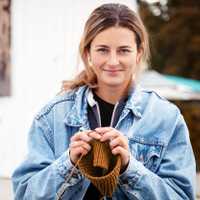Giving A Successful Presentation To A Knitting or Craft Club
By Bea Roberts
Giving A Successful Presentation To A Knitting or Craft Club
By Bea Roberts
Many knitters, be they beginners or more experienced knitters, like to join knitting clubs or circles, where they can make new knitting friends, swap ideas, pick up hints and tips etc. There are clubs for those who hand knit and crochet, as well as for those, who like myself, machine knit. Sometimes these clubs have guest speakers who come along and share their experiences, give demonstrations and talk about their world of knitting.
The first time I was asked to do this, I simply refused. How could I stand in front of a room full of people and talk about myself? The idea filled me with dread. However, after a bit of gentle coaxing by a very persuasive knitting circle leader, I found myself having to prepare something that the group members might find interesting in some way.
I decided to speak about my experiences writing patterns for publication in magazines, as that is what my main forte is. As well as giving a talk, I took some examples of my knitwear with me to show the type of garments that were being commissioned at the time, which were quite complicated, with lots of pattern, shaping, and unusual techniques, many of which the audience were not familiar with.
Although I was like a nervous wreck on the day, I needn't have been. It was a little daunting to address so many people at once, but when things got going, the time flew. I learned a lot from that first talk, and each one I did afterwards became easier than the last one.
If you have been asked to give a talk at a knitting group, women's institute, or any other interest group about your knitting, or particular craft specialty, here are a few tips which can help you to make it hassle, and nerves, free. If you have never done a presentation before, and you, like I was, are scared to death by the prospect, reading through my ideas, will hopefully alleviate the stress and give you positive ways to present a good talk.
Make Notes - It is a good idea to have, at least, some sort of outline of what you want to talk about. If you keep to a plan and not go off at tangents, it's obviously better for yourself as you can stay on track more easily, and much better for your audience, who will stay interested and not get confused by a lot of mixed up ramblings. Even sketchy notes, or bullet points will help rather than trying to rely on memory. If the nerves do just happen to kick in on the day, you will be thankful you wrote things down.
Take some of your knitting or craftwork - People like to look and touch things as well as sit and listen. Bringing physical items to show people, takes the emphasis off you alone, it stimulates conversation with your viewers and makes it more of an interaction between presenter and audience. It also encourages more questions from people, who may ask about techniques or other issues pertaining to your work. All this makes the talk more interesting for everyone, when people are questioning and chipping in with their own comments or ides.
Do you have anything to sell? - If you specialise in baby bonnets, take some. If you knit to order, don't forget your business cards. Wear your own knitted or hand crafted garments. This is to promote sales. Whether your talk is paid, or unpaid, you might as well try to generate some extra money while you are there. Encourage people to pass your details on to other people too.
Q and A - Always have a 'question and answer' session at the end. This lengthens your talk and brings in lots of other interesting conversation by your audience. This is usually the part of a presentation where everyone, including yourself, are more relaxed and conversation, and sometimes laughter, can flow.
Finally, it's easy to say try not to be nervous... that's not really very helpful, because even the most seasoned speaker can get butterflies in the tummy on occasion. What is helpful, is to remember that your audience want you to be there. They have chosen you to come along and talk, so they are already interested in what you have to say. Your audience will be on your side. They share the same interests as you, otherwise they wouldn't be there, so if you look at it in these terms, it is easier to feel confident about your upcoming talk.
Bea Roberts is a professional artist, knitwear and knitting pattern designer. She designs for various UK knitting and craft magazines and sells her lovely machine knitting (and crochet) patterns in her Etsy shop at; http://www.etsy.com/shop/beaknitting Bea also has a website at; http://www.bea-roberts.moonfruit.com where you can view her original artwork.
Article Source: http://EzineArticles.com/?expert=Bea_Roberts
Many knitters, be they beginners or more experienced knitters, like to join knitting clubs or circles, where they can make new knitting friends, swap ideas, pick up hints and tips etc. There are clubs for those who hand knit and crochet, as well as for those, who like myself, machine knit. Sometimes these clubs have guest speakers who come along and share their experiences, give demonstrations and talk about their world of knitting.
The first time I was asked to do this, I simply refused. How could I stand in front of a room full of people and talk about myself? The idea filled me with dread. However, after a bit of gentle coaxing by a very persuasive knitting circle leader, I found myself having to prepare something that the group members might find interesting in some way.
I decided to speak about my experiences writing patterns for publication in magazines, as that is what my main forte is. As well as giving a talk, I took some examples of my knitwear with me to show the type of garments that were being commissioned at the time, which were quite complicated, with lots of pattern, shaping, and unusual techniques, many of which the audience were not familiar with.
Although I was like a nervous wreck on the day, I needn't have been. It was a little daunting to address so many people at once, but when things got going, the time flew. I learned a lot from that first talk, and each one I did afterwards became easier than the last one.
If you have been asked to give a talk at a knitting group, women's institute, or any other interest group about your knitting, or particular craft specialty, here are a few tips which can help you to make it hassle, and nerves, free. If you have never done a presentation before, and you, like I was, are scared to death by the prospect, reading through my ideas, will hopefully alleviate the stress and give you positive ways to present a good talk.
Make Notes - It is a good idea to have, at least, some sort of outline of what you want to talk about. If you keep to a plan and not go off at tangents, it's obviously better for yourself as you can stay on track more easily, and much better for your audience, who will stay interested and not get confused by a lot of mixed up ramblings. Even sketchy notes, or bullet points will help rather than trying to rely on memory. If the nerves do just happen to kick in on the day, you will be thankful you wrote things down.
Take some of your knitting or craftwork - People like to look and touch things as well as sit and listen. Bringing physical items to show people, takes the emphasis off you alone, it stimulates conversation with your viewers and makes it more of an interaction between presenter and audience. It also encourages more questions from people, who may ask about techniques or other issues pertaining to your work. All this makes the talk more interesting for everyone, when people are questioning and chipping in with their own comments or ides.
Do you have anything to sell? - If you specialise in baby bonnets, take some. If you knit to order, don't forget your business cards. Wear your own knitted or hand crafted garments. This is to promote sales. Whether your talk is paid, or unpaid, you might as well try to generate some extra money while you are there. Encourage people to pass your details on to other people too.
Q and A - Always have a 'question and answer' session at the end. This lengthens your talk and brings in lots of other interesting conversation by your audience. This is usually the part of a presentation where everyone, including yourself, are more relaxed and conversation, and sometimes laughter, can flow.
Finally, it's easy to say try not to be nervous... that's not really very helpful, because even the most seasoned speaker can get butterflies in the tummy on occasion. What is helpful, is to remember that your audience want you to be there. They have chosen you to come along and talk, so they are already interested in what you have to say. Your audience will be on your side. They share the same interests as you, otherwise they wouldn't be there, so if you look at it in these terms, it is easier to feel confident about your upcoming talk.
Bea Roberts is a professional artist, knitwear and knitting pattern designer. She designs for various UK knitting and craft magazines and sells her lovely machine knitting (and crochet) patterns in her Etsy shop at; http://www.etsy.com/shop/beaknitting Bea also has a website at; http://www.bea-roberts.moonfruit.com where you can view her original artwork.
Article Source: http://EzineArticles.com/?expert=Bea_Roberts



